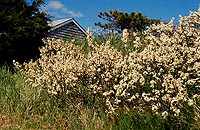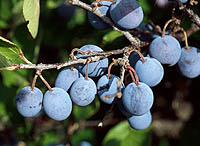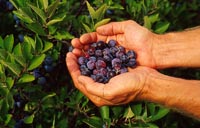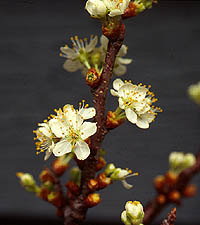Minor Fruits Home Page

Beach plum fruit

Beach plums in bloom

Beach plum fruit

Beach plum fruit

Beach plum flowers

Beach plums in native habitat
|
Beach plums are stone fruits, related to
other plums, cherries and peaches. Plants grow 4 to 10 feet tall and produce
a profusion of white or pink flowers in mid-May, later than most other
stone fruits.
The half- to one-inch-diameter fruits ripen
in late summer and are generally reddish to deep purple with a waxy bloom.
They are quite acid with a crisp, tart, juicy flesh and cherry-like pit,
and can be substituted for cherries or plums in recipes. Mostly wild-gathered
fruits are used to make jams and jellies, which are often sold in resort
areas along the coast. Plants are often quite thorny and can be used as
a low-growing hedge. Seaside plantings become gnarled and picturesque
with age. The foliage is attractive, and the bark is dark and shiny.
Growing beach plums
Grow beach plums as you would other stone fruit.
While found almost exclusively on sandy soils in the wild, beach plums
will tolerate heavier soils if they have good drainage. They require full
sun, and are hardy in Zones 3 to 7. Beach plums are popular for erosion
control and seaside plantings because they tolerate sandy soil and salt
spray.
Cultivars are not easy to come by, but Cornell researchers are working
with growers to revitalize the once-vibrant beach plum industry.
- 'Autum' has a spreading, low-growing habit and produces
a large annual crop with good size and high-quality fruit.
- 'Stearns' is a good ornamental with fruit that processes
well.
- 'Northneck' and 'Squibnocket' are recommended as ornamentals
and soil binders.
Pests
Tent caterpillars and brown rot are occasionally troublesome, and birds
especially enjoy these fruits.
For more information, see Cornell Beach Plum Project
website.
Other lesser-known Prunus species include:
Western sand cherries (Prunus besseyi)-
Small, spreading shrubs up to 4 feet tall and hardy in Zones 3 to 6. Bears
½-inch white flowers in late April or early May that ripen into ¾-inch
purplish-black fruits in late summer. Fruit is astrigent but sweet, and
used in jellies or jams and in combination with apples in pies. Plants
are native to the Great Plains and very tolerant of dry, sandy soils.
Nanking cherries (Prunus tomentosa)-
Also known as Manchu cherry, this attractive, dense
shrub from China grows 6 to 10 feet tall and spreads to 15 feet. It bears
fragrant white flowers very early in spring, which ripen into bright red
fruit about half the size of a sour cherry. Fruits are covered with inconspicuous
hairs, and are juicy and slightly acid. Plants are very winterhardy, growing
in Zones 2 to 7.
© Copyright, Department of Horticulture, Cornell University.
Website design and coding: Rachel Kennedy and Craig Cramer cdc25@cornell.edu
|